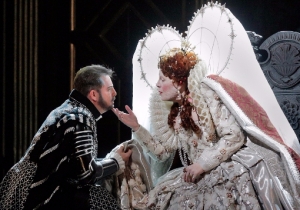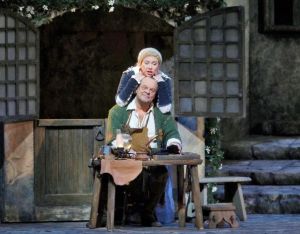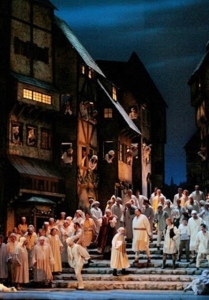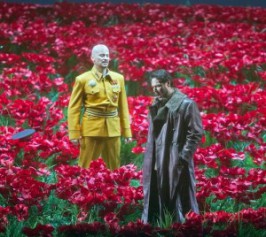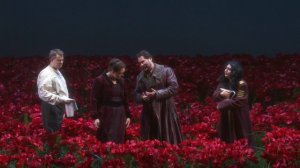
“Is it the poor house, yer honor?” (Rod Walters, illustration for Folio Society Castle Richmond)
Dear friends and readers,
This is my fourth and last report of the papers given at the Trollope Bicentennial Conference in Leuven, Belgium (see 1, 2, 3). I combine late Friday afternoon, early Saturday morning (Sept 18th-19th). I was not able to stay for Saturday afternoon, nor J. Hillis Miller’s videotaped talk, on the pleasures of Trollope’s obstinacy, and no one has (as far as I can tell) put a full YouTube up onto the Net, so I will end on an account of some of the questions and discussions that occur after and between sessions. The last panels I was able to hear were Mother (Frances), Irish (or Anglo-Irish) and Formal Trollope (his art and forms).

Frances Trollope as painted by Auguste Hervieu
Panel 9: Mother Trollope. Helen Blythe discussed specific and general parallels of which there are many between Frances and Anthony Trollope’s fictions. Frances began her career in her 50s, and saved the family from financial ruin, herself from a destroyed life with a half-mad destroyed man by writing a huge number of novels over the years. She began with how the story of an uncontrollably hot-tempered husband in Frances’s One Fault has striking parallels with Trollope’s novel of sexual anxiety, madness and competition for marital dominance, He Knew He Was Right, with its brief reprise, this time with an accent on a secret clandestine relationship, and who gets to control whom in Kept in the Dark. The underlying suggestion is the derivation of these stories from the near-breakup of Trollope’s parents marriage and her flight with Hervieu. (All discussed ably in Helen Heineman’s excellent biography, Mrs Trollope.) Ms Blythe’s theme though was Frances’s use of the “mother’s voice” in her fiction. Frances presents what it means to be a woman or man, and she took this opportunity to connect Helene Cixous’s urging of women to seize the occasions of sexual experience as a core launching pad for novel writing.
Lucy Sheenan also spoke of mothers in Frances’s fiction: while they fulfill their task of producing adults, in character they are alienated, estranged, seek to flee their immediate environment. Slave women are mother machines, but we see in Jefferson Whitlaw a mother who survives by hardening herself and resembles the mothers on Trollope’s factory floors. Women are seen as consummate actresses, containing their energy for revolt inside themselves. Martha Barnaby, at first a widow, and then remarried, is a comic version of mothering who supports a useless husband, saving her deepest affection for her children; we are told the Widow Barnaby will surely write a book defending slavery for money; when she cries we see she is not de-humanized. The mortality statistics of the era reveal agonies of exhausted underfed hard-word dying children; Frances’s factory town is pregnant with wasted bodies: the imagery of the books shows their origin in l’ecriture-femme too.

Contemporary illustration of Frances Trollope’s Michael Armstrong, Factory Boy.
Greg Vargo and Elsie Michie discussed this maternal groundwork in Frances Trollope’s fiction from other angles. Mr Vargo discussed Frances Trollope’s politically controversial condition of England novels. In 1838 Trollope wrote Jessie Philips: A Tale of the Present Day, showing us the social roles imposed on women through individual researched stories. He suggested Anthony Trollope’s criticisms of Dickens could easily be applied to Frances’s but Dickens’s Oliver Twist ends where Michael Armstrong begins. An upper class woman saves a boy suffering degrading abuse and violence in a factory; he has to leave his brother behind. Advertised in the Northern Star (1859) it was widely read as a Chartist appeal despite her denials. Frances’s novels show survivor guilt; they are contradictory, have convoluted endings, tell tales of emigration.

Laura Fraser as Emily Trevelyn and Bill Nighy as Colonel Osborne: Louis’s insecurity and madness is Andrew Davies’s emphasis
Elsie Michie offered a detailed analysis of He Knew He Was Right, showing how the novel channels changes in custody law and custom; how matrimonial cruelty is redefined so it does not depend on physical cruelty. Michie went over contemporary court cases (Bulwer-Lyttons, Caroline Norton) where the husband’s cumulative cruelty over time is at least taken into consideration. Troubled relationships and agency brought into court where legal process takes over. Ms Michie did not look at the novel from a feminist standpoint nor the more recent outlook of Mark Turner, from that of the sophisticated male reader who might see in Osborne a dark portrait of himself. Hers was like the papers earlier in the day on teaching Trollope from the angle this time of Frances Trollope as pioneer for custody and marital reform generally understood.

19th century depiction of Irish farmers stopping the aristocratic hunt
Panel 10: Irish Trollope. The speakers in this panel were in genuine disagreement. Gordon Bigelow argued Trollope’s Irish novels fail because 1) he failed to find an audience for them; and 2) he never established a set of significant tropes to present his vision through. Mr Bigelow felt many editors today do not think the Irish novel added anything different or significant to the Victorian novel; the Irish experience cannot be adapted to worlds of privilege; plots of abduction, murder, violent cutthroat action are needed. In Landleaguers we have such incidents centrally but otherwise we otherwise see purposeless activities: law gets nowhere (nullified); the hunt (which requires the preservation of the vermin, foxes, the sport was originally set up to kill) does not bring any commnity together except as protest and push-back. Trollope’s usual way is to decode tension inside a created harmony; the hunt cannot work this way because the people doing it are desperate and these is no single unified community to sustain it. There are many such riffs across these 5 novels Macdermots of Ballycloran, Kellys and OKellys, Castle Richmond, An Eye for an Eye, Landleaguers). They thus falter when it comes to speaking for the Irish. Ireland captivated Trollope; it freed him from the imprisonment of stigma, but Trollope justifies things as they are, as he did not in say The Warden where everyone is self-serving.

Ardkill Cottage in An Eye for an Eye (Elisa Trimby illustrator for Folio Society edition)
John McCourt felt that while Trollope’s Irish novels are problematic, there is much richness in them; they are successful Irish art. In the Macdermots we find an attempt to write the language according to 19th century Irish phonetics, with one of its heroes a Catholic Irish priest. It is a penetrating depiction of the destruction of an old Irish family by the Catholic Irish speculating class; Keegan is a disguised version of Trollope himself. (Mr McCourt did not mention how the house is a version of Julian Hills, the father Trollope’s father to.) When Trollope found himself “at home” in Ireland, welcomed, he set about to tell truths; intertwined the Protestant Anglo-Irish with the Catholic Irish, exposed the British colonialist police practices. The theme of hospitality and forgiveness are treated comically in his two Irish short stories, tragically in An Eye for An Eye: Neville, the English officer is the villain; though all the characters use one another. The Kellys and OKellys use the intertwining patterns and character types rich and complicated; the places described vivid with life (from kitchen to race course); we have a murderous brother, with a plangent Irish heroines who is virtuous. Mr McCourt included the two Phineas books in Trollope’s Irish oeuvre; Phineas is kept in surveillance, and thrown out when he tries to become his own man in parliament. Accused of murdering the ultimate trimmer, Bonteen, he learns how much of an outsider he remains, and cannot get himself to accept Gresham’s offer of yet another place among the English. Madame Max like Phineas is an outsider, drained of her Jewishness, can be taken in.

Fred Walker, The Vagrants, 1868
Claire Connolly meditated the image and uses of lanes in Trollope’s Irish fiction. The new systems of carriage transport and work like Trollope’s for the post office were revolutionizing and connecting the roads; these improvements represent a means of controlling people as well as the power of the British state. Good roads benefited the landowning classes; its corollary is a national school system to replace local (forbidden Catholic) hedge schools. Yet roads are where bad encounters happen; in the Macdermots they are black, desolate, muddy. Thady flees to a band of ribbon-men in the hills. Trollope remembers Scott’s Waverley and Maria Edgeworth’s Irish novels; in Kellys and OKellys the roads are part of a public network, even if we find starved, dead, mutilated bodies (Castle Richmond) along the way. In some moments roads are where people are hanged; Father John avoids walking on them after Thady’s execution. Trollope described travel in Ireland as having people acting with warmth, geniality, but it is also harsh: Ccrpse-like women and dead babies are found alongside the road. She said “these are scenes of potential connectivity and dangerous failed infrastructure. They reflect social change, lived realities.” She even brought geological time in Ireland in.
At this point the day came to an end and people went off to have dinner.
******************************

Lady Glencora (Susan Hampshire) and Madame Max (Barbara Murray) waiting for Phineas to return from London to Matching Priory after his acquittal (Palliser 9:19, scripted Simon Raven, from Phineas Redux)
Panel 11: Formal Trollope. I heard the first two papers of the day. Claire Jarvis’s “Almost Trollope” traced Trollope’s uses of the word “almost,” which she found were in one novel “almost 285 times. She close read the typical sentence forms and content in which this word occurs. Trollope becomes a kind of Henry James novelist, with Trollope also preferring incident to event. Almost a reference to something not quite happening, to being at one remove, to not completing something, to sheering away from violence (characters are “almost angry”). “Almost” signals a narrative attention, carefulness. It signals detachment, deflation. There has to be something uncanny in creating enveloping realism; a schism at the heart of the novels. Phineas is “almost silenced;” he “almost” sets down his office; Mary Flood “almost” reads his letters. The narrator therefore can’t see the letter. He is not sure of the vividness of something; the word captures an energy just out of reach. Lady Glencora “almost hesitates” as she is fleeced or cheated or nearly run away with by Burgo (nearly). D.A. Miller says there is no need for police in Trollope or for the reader or Trollope to take sides; we don’t care about who wins, the point is to collude in the surveillance in order to embed yourself. But does Finn not fear his desire to kill Bonteen? and need to exorcise this by re-enacting the murderer’s walk. He “almost” killed Mr Bonteen. It’s an unfinished murder as Emilius is dismissed from the narrative. At the level of the sentence Trollope offers us depth through eluding us.
Daniel Wright’s paper analyzed Trollope’s formal logic in his narratives. He argued Trollope’s famous dictum that the novelist should get all his meaning into his sentences, and leave none out, and be totally transparent is a fantasy. But as a goal of his novel’s craft we begin to see he wants the sentence to be a transparent medium at any rate. He wanted certainty (not almosts). He sought ease for the reader, directness himself, clarity as a way to rivet the reader. George Eliot practiced a contrasting art with her desire to escape the vigilance of the reader, her multivalent use of language, with subtle shades of suggestive meaning.
*******************************

Phineas (Donal McCann) and Lord Chiltern (John Hallam) sharing a bottle of champagne in their club as they become friends (4:7, scripted Simon Raven, from Phineas Finn)
Speaking in general, the talk afterward was mostly in praise of the papers or the person speaking (yes): no surprise as this was a conference made up even largely of people who had spent years reading and/or writing and researching Trollope. There were far fewer graduate students, Victorianists and mid-level career people as well as fewer people from the Trollope society than there had been at Exeter. Even if the organizer kept saying how Leuven was so available to the all the world, it’s not. Many people had to make three connections at least to get there, had traveled many hours and it had been expensive. If you lived in the UK in 2006, you had only to take the train (or drive); from Ireland you could ferry and then take a train.
So, on Ordinary Trollope (Panel 1) The person who argued that Melmotte could not have gotten away with what he managed, cited a good deal of legislation 1856 the Limited Liabilities Act, 1874 the Fraudulent Trustees Act, and that no one objected to the thesis. Francis O’Goorman did say that TWWLN could be regarded as a proto-thriller. Someone asked about the 1844 Bank Act which made the UK banks the only legitimate producers of bank notes, and these had to be backed by bullion. Trollope was interested in what backs up a bill, in the person who co-signed. Deborah Morse offered the idea that Trollope maintained deep feelings about his personal life and experiences across the decades and these were poured into his novels.
For Political Trollope (Panel 2) Helen Small had cited many particulars of the Beverley election, and many reform bills to stop bribery, describing a number of individuals beyond Henry Edwards; there were questions about this material. To me the more interesting ones were conceptual. Who stood for negative and for positive liberty in Trollope’s Phineas Redux? People asked Mr Aguirre about the Eyre controversy (the indiscriminate punitive slaughter of native people in Jamaica). Trollope was for uniting the world, but for what purpose? (was a question I tried to ask and didn’t get a chance). Someone asked (politely) how can you say Trollope pro-northern, and pro-abolition, and yet not bring in as contradictory how he wrote about the post-emancipation problem as wrecking the US economy, just like Carlyle (with the same insinuating inferences)? Mr Aguirre fell back (so to speak) on suggesting that (for Trollope?) “colored people” as they were then “could not help society move into progress.” Of course the reply which was not forthcoming is (as impolite, pressing too much), progress for whom?
Gopnik’s essay in the New Yorker was quoted on Monk as a mouthpiece for Trollope’s political vision (at its best?) Lauren Goodlad replied that with the whigs losing out (the liberals), Trollope feared a Disraeli take-over. Prof Skilton spoke of The Fixed Period as a satire on coercing people for “their own good,” and on utilitarianism. H.M.S Bright: the ultimate weapon is to destroy the whole country with one shot. Did Bonteen represent the new reliance on a technological world? someone said the regional and provincial worlds wanted machines too: they made for great wealth for some. Laura Goodlad asserted that we must see two Trollopes: “a different man writes the political writing, non-fiction and autobiography.”
Onto the Psychological/Epistemological Trollope (Panel 3): This was one of the panels where there was “almost” (to use a Trollopeian word) no time to say anything afterward. More than one of the papers had gone over the time limit. So I am left to voice my own objections to parts of Prof Polhemus’s paper. The thrust of the argument was Trollope was in effect in his fiction questioning and undermining marriage. I’m not sure about the latter, but the real problem in the paper (as I saw it) was he justified Trollope in salivating over women’s sexuality, especially the stories in the canon where an older man dominates a young girl (this is the thrust of his book Lot’s Daughters). Andrew Davies in his film adaptation saw this as the center of the Palliser-Lady Glencora marriage itself. How dare Sir Roger demand Henrietta marry him in HKHWR? Clara is at a severe disadvantage and doesn’t begin to know that love is conducted a series of negotiations in public. The arguments present women as gaining something in the “Editor’s Tales” and in this novel as compliant which is flat contradicted by the picture: Jael drives a nail through Sisera’s head. I wondered how Effie felt about Millais’s portrait of her sister — I would not have liked that if it had the meaning suggested. I wanted to ask if this is feminism? Feminism has become the unspeakable and dread word so a protest against sexuality presented in this light could (as it was in the 1960s) be seen as priggish, when the problem is the female powerlessness.

The Dormer residence (which they lose) in Ayala’s Angel (Folio Society illustration)
I was surprised that he had not brought up Ayala’s Angel where we again have a portrait of an artist that alludes to Millais: I asked him about it later. It’s a Proustian book, half-defending erotic enthrallment, but it also exposes the indifference of the artist to his family (especially on money matters), and approves of sexuality in art as a pleasure when it’s controlled by conventional marriage patterns.
The Technoscience Trollope session (Panel 4) had to be cut short as the president of the Irish College was coming to speak to and welcome us, and then we segued right into the Printed Trollope (Panel 5) which ended in a “launch” of the graphic novel, Dispossession. Useful questions were asked of Simon Grennan and David Skilton during their talks so (given it was so late) there was no need for further talk. I regretted there was no questioning of Prof Skilton about what he was pointing to when he suggested people are not reading the words in front of them when they read Trollope’s Autobiography.
Both the first two panels on Friday (Teaching Trollope and Australian Trollope, 6 and 7) ran over time. There was a brief moment where someone asked Mark Turner about the effect of seriality and he replied that modern younger adults “stick with it,” and that it’s a form of reassurance (against I’d say chaos and death). It’s become a crucial way people experience a cultural event. On my paper, I regret earnestly that I had no sense of what anyone thought of my paper for real: you do get hints and suggestions by the talk afterward. I was congratulated kindly by Prof Polhemus and thought that Laura Goodlad was talking about my paper when she objected shortly after I finished to these “literalist” kinds of readings. I had worked hard and hoped mine would be a contribution since I was invited to come. I worry that my range was too broad, my references too dense. But I have put the text online if anyone wants to read it slowly.
The response to Modern Trollope (Panel 8) was quiet astonishment and appreciation — or so I thought. I had heard some squawks (in protest) to Prof Kincaid’s satiric burlesque of literary scholarship and his (more earnestly delivered) radical critical reading and indirect comments on the present audience as typical of a scholar’s conference. Prof Kincaid replied to one comment that “reading is a professional set of agreements; not all agreements are bad,” but awareness of them controls our behavior. He was suggesting we should admit to this and to the ludicrousness of some of our “discourses” to those outside the world of these parameters. Maybe we should listen to those who talk very differently about reading and Trollope. Someone said that Elizabeth Bishop’s protest poem (in effect, from its 1950s political content) drew out aspects of Trollope’s personality the mainstream reader finds it difficult to discuss, much less try to understand. She and Frances Trollope both defied the hegemonic (macho) male and upbeat viewpoint. John Bowen saw Trollope as enacting insensitivity to fool us. I loved the passages Mr Caddia had quoted.
There was not enough time after Mother or Frances Trollope (Panel 9), but the talk after the “Irish Trollope” (panel 10) was long, meandering but of real interest as fundamental questions arose about how we define and de-limit Trollope. I was too tired to get down details by that time — mostly Irish politics today, some comments on Thackeray’s books of touring in Ireland. The following morning I could not stay beyond the “Formal Trollope” (Panel 11) as we had to make our cab to get to our train, to get to the first of two planes, before we were to reach another train.
So, if this reaches anyone at all with the power to make Hillis Miller’s lecture on YouTube available to all on the Internet, I hope that person or people can and will do the right thing.
In the meantime I thought I end on a poem mentioned by Claire Connolly (but not read aloud) in her “Lane-ism” Eavan Boland’s “The Famine Road.” Trollope insisted that the gov’t should not simply give food or help to the starving Irish in 1847 but that the starving people work on these useless roads (lest they get used to not working for money, lest they “disrupt the “economy” by bypassing capitalist networks), and there are scenes of this roadwork being done in Castle Richmond where Trollope portrays these people semi-hostilely:
The Famine Road
‘Idle as trout in light Colonel Jones,
these Irish, give them no coins at all; their bones
need toil, their characters no less.’ Trevelyan’s
seal blooded the deal table. The Relief
Committee deliberated: ‘Might it be safe,
Colonel, to give them roads, roads to force
from nowhere, going nowhere of course?’
‘one out of every ten and then
another third of those again
women – in a case like yours;
Sick, directionless they worked; fork, stick
were iron years away; after all could
they not blood their knuckles on rock, suck
April hailstones for water and for food?
Why for that, cunning as housewives, each eyed –
as if at a corner butcher – the other’s buttock.
‘anything may have caused it, spores,
a childhood accident; one sees
day after day these mysteries’
Dusk: they will work tomorrow without him.
They know it and walk clear; he has become
a typhoid pariah, his blood tainted, although
he shares it with some there. No more than snow
attends its own flakes where they settle
and melt, will they pray by his death rattle.
‘You never will, never you know
but take it well woman, grow
your garden, keep house, good-bye.’
‘It has gone better than we expected, Lord
Trevelyan, sedition, idleness, cured
in one; from parish to parish, field to field
the wretches work till they are quite worn.
then fester by their work; we march the corn
to the ships in peace; this Tuesday I saw –
out of my carriage window, your servant Jones.’
‘Barren, never to know the load
of his child in you, what is your body
now, if not a famine road?’
Not only the people under the gun but the animal life should bear some witness. When I came to the end of my reading for my paper, I found myself at the close of Trollope’s Australia where he goes hunting and he and the others gun down kangaroo. How horrible, how truly terrible was the behavior of Trollope and his fellow hunters. Trollope records the traumatic distress and crazed behavior of these animals under such an assault, and also their tenacious love for their young. How I wished that the kangaroos had been able to kill the men with their guns (yes I did) who were ferociously terrorizing them so as to elicit frantic savage helpless self-protection and then murder them.
We killed, I think, seven in two days, – and had other runs in which we lost our prey. The ‘old man’ kangaroo when hard pressed will turn round and fight the hounds, – or fight the man who comes up to knock him over. And he fights with great power, inflicting terrible wounds with his fore paws. In New South Wales I saw a kangaroo which we were hunting catch up a terrier in his arms, and carry the little animal in his embrace throughout the run. He was not, however, able to hurt the dog, who, when the affair was over, seemed to come quite undismayed out of his difficulty. And I saw also a female kangaroo, when the hounds were after her, throw her kid out of the pouch in which she carried it. On that occasion the kid was killed and the mother escaped. They will carry their young one as long as it is possible for them, and then throw him out almost without losing a stride (Anthony Trollope, Australia and New Zealand, from “Sports” 741).
Miss Drake

Abram Louis Buvelot (1814-88), Australian landscape (much idealized)








